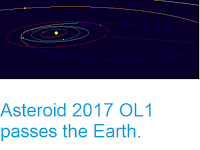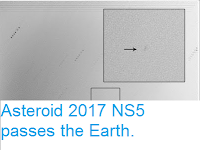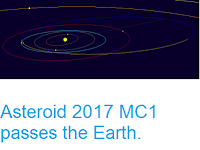Asteroid 2017 FQ64 passed by the Earth at a distance of about 10 860 000
km (28.3 times the average distance between the Earth and the Moon, or 7.26% of the distance between the Earth and the Sun), at about 3.50
am
GMT on Saturday 29 July 2017. There was no danger of
the asteroid hitting us, though were it to do so it would have
presented a significant threat. 2017 FQ64 has an estimated
equivalent
diameter of 120-390 m (i.e. it is estimated that a spherical object
with
the same volume would be 120-390 m in diameter), and an object of this size would be predicted to be capable of
passing through the Earth's
atmosphere relatively intact, impacting the ground directly with an
explosion that would be 60 000-1 650 000 times as powerful as the
Hiroshima
bomb. Such an impact would result in an impact crater about 4-5 km in
diameter
and devastation on a global scale, as well as climatic effects that
would last decades or even centuries.
The calculated orbit of 2017 FQ64. Minor Planet Center.
2017 FQ64 was discovered on 21 March 2017 (122 days before its closest approach to the Earth) by the University of Hawaii's PANSTARRS
telescope on Mount Haleakala on Maui. The designation 2017 FQ64 implies
that it was the 1616th asteroid (asteroid Q64) discovered in the second
half of March 2017 (period 2017 F).
2017 FQ64 has a 1044 day orbital period and an eccentric orbit
tilted at an angle of 4.41° to the plane of the Solar System, which
takes it from 0.97 AU from the Sun (i.e. 97% of he average distance at
which the Earth orbits the Sun) to 3.06 AU from the Sun (i.e. 306% of the
average distance at which the Earth orbits the Sun, and almost three
times as distant from the Sun as the planet Mars). It is therefore
classed as an
Apollo Group Asteroid (an asteroid that is on average further from the
Sun than the Earth, but which does get closer). As an asteroid probably larger than 150 m in diameter
that occasionally comes within 0.05 AU (7 480 000 km) of the Earth, 2017 MB1 is also
classified as a Potentially Hazardous Asteroid. 2017 FQ64 also
has frequent close encounters with the planet Mars, which it is
thought to have last passed in November 1937, and is next predicted to
pass in April 2026.
See also...
Follow Sciency Thoughts on Facebook.







